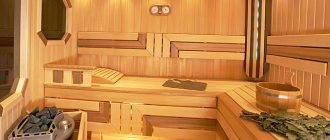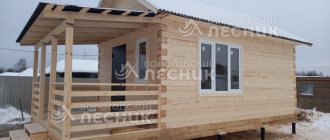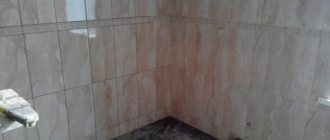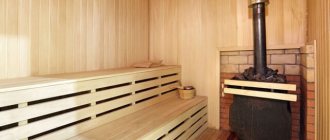Timely and high-quality insulation of saunas and baths can provide reliable protection of finished premises structures from high humidity, fungus and further destruction.
Foil insulation for a bathhouse promotes effective energy saving, which leads to the accumulation of 98% of the heat in the room. This allows you to save on fuel and significantly speed up the steam room heating process.
It is recommended to use wear-resistant foil as a thermal insulation material.
Foil layer for a bath: its functions and features
Would-be builders have always believed that foil is of no use when arranging a bathhouse. However, this opinion is wrong, and with the right approach to its installation, you can achieve a special effect.
Foil material can have a different structure: smooth or ribbed PHOTO: bani.io.ua
In fact, foil is a thin layer of aluminum. When mounting it on the walls under wooden cladding, all the heat that the boiler produces reaches the surface and is reflected back. Thus, all thermal energy remains in the room. This layer is used together with insulation or separately. The corresponding material is capable of reflecting about 97% of the heat generated by the furnace.
When purchasing foil for a bath, you must ensure that the foil is intact, without perforation PHOTO: skif53.ru
Related article:
Finishing the bathhouse inside. Photos and examples. In a separate publication you will find interesting ideas for decorating steam rooms and relaxation rooms, and also learn the main stages of installation.
Bottom line
The process of insulating any room, including a bathhouse, is an important stage in the work. Not only the consumption of energy sources, but also the safety of building structures, as well as indoor comfort, depend on how well the work is done and how effective the materials are selected. Nowadays, materials for thermal insulation can be chosen from a huge number of products on the market. It is important to know that foil for insulating baths is an integral part of the process of creating optimal operating conditions in the future.
Types of reflector and its performance characteristics
There are several options for foil reflectors, which are usually used when arranging a modern steam room. Let's consider which of them are used in practice, which ones have operational features.
Material on a high-quality basis PHOTO: alibaba.com
Kraft foil “Izolar”: what kind of material, its characteristics
Kraft foil is a type of aluminum sheet. It is made with a seal, which makes its structure simpler. Differs in the following technical features:
- environmentally friendly material;
- insulator thickness - 0.03-1.0 mm;
- operating temperature - 100ºС;
- reflectivity - 95%.
This variation of material is very convenient for installation. It is characterized by increased strength compared to ordinary foil, which does not have a base.
Usually the material has a pimpled base. Occasionally a smooth reverse side is used PHOTO: m.bud.inforico.com.ua
Foil fabric as a thermal insulation option
Foil fabric is a special structured foil. It is intended for installation in the ceiling area of the steam room. The material is based on thermal fabric and aluminum foil. Characteristics include:
- width - 100 cm;
- foil thickness - 11-35 microns;
- operating temperature - up to 500ºС;
- Suitable for replacing fiberglass.
When heated, this material does not emit toxic substances or unpleasant odors.
Supplied for sale in large tubes of several hundred linear meters PHOTO: russian.alibaba.com
What is rolled foil?
As a rule, rolled foil does not have a reinforcing base. This is a fairly thin material that is easily torn and deformed. Its technical characteristics are:
- thickness - 0.007-0.2 mm;
- width - 100-150 mm;
- operating temperature - 650ºС;
- thermal radiation - up to 97%.
Does not emit toxic substances and also resists corrosion.
Elastic and durable material PHOTO: sanpol.ua
Foil polyethylene foam
The basis of this raw material is foamed polyethylene. They try to use it to retain thermal energy in homemade baths and saunas made of wooden logs. Occasionally used for soundproofing cars. The main technical characteristics are as follows:
- coating thickness - up to 15 microns;
- has low dynamic resistance;
- Laying method: 10 cm overlap;
- operating temperature maintenance - 300ºС.
To fix this material, special metallized tape and wooden slats are used.
Optimal for installation in baths with thin walls PHOTO: russian.alibaba.com
Foiled polystyrene foam
Material equipped with foil on both sides. This coating can prevent heat from leaving the room and prevents moisture from entering. Its features are:
- porous or corrugated structure;
- high resistance to external loads;
- ease of installation and operation;
- ease of care.
However, you should not nail the canvas with nails with a cross-section that is too large, as this may cause the insulating material to be damaged and lose its qualities.
The porosity of the material affects the ability to retain heat PHOTO: stroy-podskazka.ru
Foil mineral mat in mats and rolls
It is produced in the form of slabs and rolls. It has increased thermal insulation properties. Suitable for baths, saunas and industrial steam rooms due to its ability to withstand high temperatures. The characteristics of the material are as follows:
- thickness - 5-100 mm;
- variable length and width;
- heat reflection - up to 97%;
- operating temperature range - from -60ºС to 300ºС.
On a note! There are a large number of foil materials; one of the most expensive is the “ISOVER Sauna” heat insulator. It is suitable for use in specific conditions, as it has all the necessary characteristics.
If the foil is damaged, the entire insulation loses its properties. PHOTO: uteplenieplus.ru
Rolled aluminum foil
Foil is produced in both rolls and sheets. Roll material can have a thickness from 0.007 to 0.2 millimeters, a width of 10–1500 millimeters. The percentage of aluminum content in it is up to 99.5%.
Depending on the type of surface, foil is:
- smooth, without additional finishing;
- for finishing;
- finishing
According to the scope of application, the material is divided into canvas:
- food;
- technical;
- tape
Depending on the manufacturing method, foil is distinguished:
- soft (annealed), marked “M”;
- solid (unannealed) – it is assigned the letter “T”.
A quality product is a fabric that has no folds, stains, tears or other inclusions on the surface. When viewing a thin fabric against the light, it should have no tears or tiny holes. Thick foil is allowed to have a small number of holes, which is regulated by the technical parameters of the equipment used.
Thin fabric is wound on bushings having different diameters. Thick foil is produced in sheets.
Before starting insulation work, developers are interested in how much foil for a bathhouse costs. Domestic roll products will cost less than imported material. With a roll length of 25-30 meters, the price will be approximately 20-30 dollars.
Advantages and disadvantages of the material
Foil usually always comes complete with another type of insulation. It is rational to install it in combination with glass wool and other denser materials. If these conditions are met, the material will have the following advantages:
- Vapor barrier and thermal insulation - thanks to this, hot steam does not pass into the middle of the insulating material, thereby preserving its properties, as well as the heat inside the room.
- Fire safety . The material can withstand high temperatures and is not flammable. Prevents fire from spreading to other walls.
- Possessing good soundproofing properties . Suppresses noise from the street and inside the steam room by almost 70%.
- Reducing the heating time of the bath . Thanks to properly equipped insulation of the internal walls, heat will quickly fill the steam room and be retained in it.
It is better to paste only with special tape. Ordinary tape will not withstand the weight of insulation PHOTO: potolok-exp.ru
Scheme of thermal insulation with foil in a bathhouse made of timber PHOTO: v-banyu.ru
Despite the large number of advantages, this material is not without disadvantages. These include:
- constant formation of condensation;
- you can’t do without ventilation equipment;
- air does not penetrate well, which can cause dampness and mold;
- poisonous properties of aluminum (this metal can glow in the body).
Proper care of the room and regular ventilation can reduce all the disadvantages to a minimum. Therefore, after each bath, you should not forget to open doors, windows and vents.
When insulating the ceiling, they try to use individual technology PHOTO: deluxemm.ru
Performance properties of foil
First you need to choose the right type of foil. You cannot use its food analogue, since the material has low strength. For baths, technical varieties are used with a thickness of up to 300 microns. But it is not installed on the walls either - thermal insulation materials are additionally installed.
The foil is made of aluminum, which determines its performance properties:
- does not corrode, which is important for rooms with high humidity;
- can take different shapes, bends easily;
- does not allow water to pass through;
- reflective properties - most of the thermal radiation returns back to the steam room.
To equip a bathhouse, aluminum foil is used in combination with other materials. Despite its advantages, it does not have heat-insulating properties, which is a prerequisite for a steam room.
Which foil manufacturer can you trust?
There are a sufficient number of brands on the building materials market that specialize in the production of foil insulation. Among all, three manufacturers can be distinguished.
- Izolon . The concern is located in Izhevsk. Specializes in the production of foil and plastic. Special technologies are used to produce insulation. The material is available in stitched and unstitched form.
- Penofol . This manufacturer produces thin material with no backing. At the same time, the structure is quite strong and reliable.
- URSA . One of the leading manufacturers in Spain. It produces high-quality insulation materials of various thicknesses and structures. This insulator is also sold in Russia.
When choosing a brand, attention is paid to those brands that promise high quality and compliance with all GOSTs.
The remains of the foil sheet can be used in places where the thermal insulation is damaged PHOTO: klevo.net
Criteria for choosing insulation for a sauna
Layers of materials during the construction of a frame bath
The required thickness of insulation for a bathhouse is determined in accordance with the thickness of the wall and the type of material for its construction. Depending on this, you choose whether you need to install only a foil insulator or use another type additionally.
Selection criteria:
- brick, concrete with a thickness of 350 and more will require insulation with a thickness of 80 - 100 mm;
- concrete, brick 250 – 350 mm – insulation 100 – 150 mm;
- frame made of wood with a thickness of 100 - 150 mm - insulation 60 - 80 mm;
- log wall 150 - 200 mm - cold insulator 40 - 60 mm thick;
- wooden frame thicker than 200 mm - insulation 20 - 40 mm.
The indicators are applicable only for bath walls, taking into account that a foil layer will be used, which is directed into the steam room. The best way to reduce heat loss is to use a combination of foil insulation and traditional polystyrene foam and glass wool.
Rules for choosing foil for a bath
Having studied all the possible options and characteristics of foil materials, you can make the right choice. To do this, you need to take into account a few simple criteria.
- It is better to give preference to foil with a backing. It is easier to install and of higher quality in operation.
- As for the operating temperature, the blade model must have indicators of at least +100ºС. Otherwise, the material will begin to deform in the steam room (fortunately, you rarely see such a thing).
- When purchasing, it is advisable to analyze the seller’s opinion about the material you like; moreover, you can also read reviews from real users.
- When purchasing a material in combination with a substrate, it is important to know about its temperature resistance.
- The permeability of the foil, with or without backing, should be no more than 0.01 g/m².
As for the thickness of the material, it all depends on how much insulation the bathhouse needs. If the room needs to be insulated from loss of thermal energy, then you can get by with ordinary thin heat-resistant foil.
Foil with insulation can be installed under metal profile sheathing PHOTO: proraboff.rf
Foil for a brick bath
Brick walls do not have good thermal insulation, as they have gaps between the seams. For such premises, foil fabric is used over the entire area. Mounted directly on partitions. A small space is left, after which the sheathing and sheathing are done. Therefore, it is better to buy material with a thick backing.
Diagram of the heat-reflecting properties of foil PHOTO: expertbani.ru
In a steam room with concrete walls
Here the usual aluminum modification is not suitable. In this case, it is better to use options with some kind of substrate. This allows you to achieve effective vapor barrier and reduce the risk of dampness in the walls.
Foil with insulation can be installed under metal profile sheathing PHOTO: proraboff.rf
The material is quite fragile, so it is mounted together with an assistant PHOTO: m-strana.ru
The principle of operation of foil insulation
The walls in the bathhouse are insulated with foil to preserve heat.
The insulator is based on a layer of foamed polymer particles, on which a foil coating is applied. The polished aluminum layer has a reflective coefficient of 97%; it is glued using high-temperature welding.
Thermal insulating qualities are based on the effects:
- insulation of walls from internal vapor;
- reflection of energy into the room.
Folgoizol easily absorbs noise, so it is often used for sound insulation. The rule that allows the insulator to reduce heat loss is to place the layer with the shiny metal side inside the steam room.
The material is not overlapped, but aluminum construction tape is used for joining. There should be a small ventilated gap between the finish and the insulation to reduce heat transfer through adjacent hard surfaces.
One layer of penofol will not provide the required insulation efficiency. The material is used separately to reflect infrared rays or mounted in combination with traditional insulation. Thin foil insulation allows you to reduce the thickness of the insulating layer. Foiled polystyrene foam is used inside and outside the bath.
Popular Insulating Foil Models
Many people prefer not so much the brand as the material they like. It is often chosen based on its external features and performance characteristics. The HomeMyHome editors offer a review of worthy models.
| Illustration | Model | Characteristic | Price as of October 2021, rub. |
| ELTETE (reinforced foil) | · roll; · dimensions 1.25×24 m; · area 20; reflectivity 97% | 1900 | |
| Bath foil 100 microns | · roll 100 m²; · reflectivity 97%; · not a heater | 1200 | |
| Alucraft - foil | · creates a vapor-tight barrier; · density 0.12 kg/m³; · reflectivity up to 97%. | 417 | |
| Paper based foil | · dimensions 1.2×25 m; · area 32 m²; · suitable for installation on walls and insulation | 1100 | |
| Mosfol type A insulation - foil | · one-sided foil and insulation; · dimensions: 1.2×25 m²; · thickness 3 mm; · operating temperature -60ºС – +100ºС; · foamed polyethylene | 35 |
Megaflex
This is bath foil that has higher quality parameters compared to its competitors. Megaflex can be used at temperatures above 300 degrees. Bath foil is highly reflective. If the installation technology is followed, this product will help create a sufficiently sealed system, which prevents the spread of steam outside the bathhouse.
Tips for installing foil
It is clear how to attach foil to the walls of the steam room. However, do not neglect the following tips.
- To install insulation, it is necessary to install a separate sheathing.
- Sufficiently thick foil sheets are best glued joint to joint using aluminum tape.
- Damaged canvases must be sealed with the same tape.
- Insulation and sheathing cannot be done closely. It is important to leave a distance between materials of at least 3 cm.
- The insulation near the windows must be measured closely, and after installation it must be covered with sealing tape around the perimeter of the frame.
For ceilings it is better to use super-strong foil material PHOTO: kakpotolok.ru
Soft material is installed on the prepared sheathing PHOTO: uteplix.com
Foil fixed with slats with insulation PHOTO: kubankrovmontag.ru
Follow the installation requirements and be guided by the performance characteristics of the material when using it. Also ask questions about the topic of publication and do not forget to rate the article.
Step-by-step instructions for insulating a bathhouse
To begin with, we note that if the steam room is small, then foil in rolls or kraft foil, the thickness of which is at least 0.3 centimeters, will be quite sufficient. But if the steam room is quite large, then it is better to give preference to materials based on mineral wool. Also, be sure to think about how the condensate will be drained: if the ceiling is insulated, then the foil from it must be taken to the walls, and if the latter are insulated, then to the floor. The overlap should be approximately 15-20 centimeters, and all joints, we repeat, should be taped with metallized tape.
The installation process itself is not complicated and consists of several simple steps. Let's look at the features of each of them in more detail.
Step one. To begin, build a sheathing on the walls using a 5x5 centimeter beam. As for the pitch of the sheathing, in this case it depends on the width of the insulation. If it is 60-120 centimeters, then the step, accordingly, should be 60 centimeters; for foil, the width of which is 100-150 centimeters, this is 50. To attach the bars, use self-tapping screws of a suitable length.
Step two. Place insulating material between the sheathing beams. Try to do this in such a way that the heat insulator does not extend beyond the level of the slats.
Step three. When the main insulation is installed, lay a foil covering on top of it, always placing the latter with a reflective layer inside the room. To seal the joints between the sheets, you can use metallized tape, but remember that the glue, being under prolonged exposure to high temperature, softens, which means that the sheets may well separate, which leads to a violation of the tightness of the entire coating.
It is advisable that the bath foil be fixed with nails or staples - the latter should be nailed directly to the bars. And if the width of the foil is large enough, then it should be fixed both at the edges and in the center.
Step four. Cover the fixed foil with clapboard, not forgetting about the air gap 1.5 centimeters thick. This layer is necessary in order to reduce the thermal conductivity of the foil in order to maximum reflect all the rays that hit the coating back into the room. Obtaining this kind of air “pocket” is possible thanks to the construction of a wooden sheathing under the lining. For this sheathing, try to use bars, the thickness of which is within 1-2 centimeters, and for fixation, use the same self-tapping screws.
Sometimes the sheathing can be built on top of the insulating layer - in this case, the foil will be stuffed immediately over the entire area of the steam room, even onto the beams. If so, then there is no particular need to create air “pockets”, and the lining can be fixed directly to the sheathing. However, practice shows that the use of combined materials, including a foil layer, is preferable not only in economic terms, but also because of the significant simplification of all installation work.











